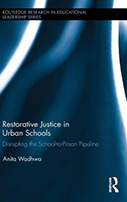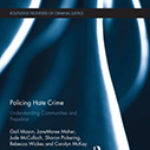Restorative Justice In Urban Schools: Disrupting The School To Prison Pipeline

Author: Anita Wadhwa
Publisher: London: Routledge, 2017. 170p.
Reviewer: Marsha Rampersaud | May 2018
Introduction
In 1994, the U.S. Department of Education implemented the Gun-Free Schools Act, which mandated a one-year expulsion for any student found in possession of a firearm on school property. The Act was enacted to combat guns, drugs, and violence, which were widely believed to be rampant in schools and the wider community. Since its inception, it has been amended to widen its scope: in 1995 to apply to offenses involving possession of weapons, and again in 1999 to apply to drug and alcohol use and fighting. The practice of attaching predetermined consequences or punishments to specific offenses has come to be known as “zero tolerance.” All schools receiving federal funding are required to comply.
Wadhwa argues that as a result of zero-tolerance policies, schools have come to rely excessively on suspensions and expulsions to discipline students. In practice, zero tolerance has come to mean the swift and severe punishment of all offenses, regardless of how minor. This method of discipline is problematic for a number of reasons, but principally because of its potential long-term negative consequences for students, including reducing their chances of graduating, becoming employed and engaging with the broader community in positive ways. Wadhwa argues that these strict punitive measures have contributed to the school-to-prison pipeline, which furthers the encroachment of the criminal justice system on the education of the most academically vulnerable students.
Wadhwa is critical of zero-tolerance policies because they have been largely ineffective in improving behaviours like truancy, fighting or disrespectful student actions: thus, the policies have not created the safer schools were promised by proponents. Instead, she makes the case for restorative justice as the preferred alternative to punitive disciplinary measures. The latter, she argues, would allow educators to begin uncovering and addressing the roots of misbehavior and to consider how exposure to concentrated disadvantage in communities: these root causes include violence, poverty, lack of access to health care, exposure to lead poisoning and unhealthy food, and limited economic resources and opportunities. To suspend and expel these vulnerable students at excessive rates is contrary to the aim of restorative justice. Moving toward restorative processes, she argues, has the potential to support the success of these vulnerable students, and to disrupt the school-to-prison pipeline.
Wadhwa cites the restorative justice literature in drawing a link between students’ race and disciplinary practices in schools. She claims that “while suspensions have an impact on students in all communities, zero tolerance is more punitively and subjectively applied when sanctioning students of colour.” She argues that this effect is not accidental. Drawing on the work of Alexander (2010), Wacquant (2000), and Cavanagh (2009), Wadhwa suggests that schools are the newest in a series of “peculiar institutions” that have developed in the United States over time to categorize, repress and disadvantage black Americans. She focuses on educators who are actively trying to disrupt the school-to-prison pipeline by implementing the restorative justice paradigm from the ground up. Few studies have so closely documented this transition.
Using a combination of interviews, participant observation, and portraiture, Wadhwa conducted fieldwork at two urban high schools in Boston. Her work addresses the following research questions:
[1] How do urban high schools transition from zero-tolerance policies to restorative practices? [2] What roles do students, educators, parents and community members play in such a transition? [3] What strides were made in replacing punitive disciplinary practices with restorative ones? [4] How was race explicitly addressed or not addressed during the implementation of and practices of restorative justice?
Wadhwa is well qualified to take up this inquiry: she has completed doctoral studies in education and has classroom experience in an alternative education program. Her experience and training contribute to thoughtful, astute insights throughout.
Restorative Justice in Practice
To address her first three research questions, Wadhwa participated in talking and healing “circles,” sat in on classes, observed teachers’ professional development training, and interviewed various stakeholders, including students, teachers, administrators, parents and community members at both research sites. She took note of how disciplinary incidents were referred to circles, the experience of participating in circles, and how different stakeholders responded to and evaluated the restorative process. Though she did not take notes during the circles, she attempted to stay true to the words of her participants and she supplemented her notes by interviewing them. She further provided participants with drafts of her work so they could offer feedback and thus contribute to its overall accuracy. I am convinced that her methodology allowed her to capture the complex processes involved in transitioning away from punitive discipline toward restorative justice practices.
From her vantage point, Wadhwa was able to observe the victories and challenges that arise in this transition. Wadhwa reports tangible successes, including higher attendance rates, as well as lower suspension rates and a decline in fights at one of her research sights. She also saw firsthand how circles could deepen students’ relationships with each other and with their teachers as they came to learn about each other’s life contexts outside of school. She also observed a broadening of the concept of “community” that went beyond geography, including the involvement of community members (including parents) in restorative practices. Thus, even when changes were not tangible or quantifiable, Wadhwa reports that adopting restorative philosophies was an important first step in positively transforming a formerly punitive school culture.
Wadhwa also highlights the difficulties of implementing restorative programming, whether taking a “top-down” or “bottom-up” approach. When implemented from the top she observed: a difficulty amassing support from teachers who believed punitive discipline was necessary to keep students accountable; how existing tensions between teachers and administration could undercut possible support for the program; and that teachers who were already exhausted and/or burning out might not have the capacity to develop the program, even if they did theoretically support restorative philosophies. And from the bottom up, Wadhwa witnessed a fractured response to the program. Specifically, working against a school-wide punitive culture meant: facing skepticism about the follow-up and enforcement of agreements; lack of support to implement labour-intensive alternatives to suspension; and an overall impatience to see results, even though such a program would typically require time to truly take root. While much of the literature attempts to garner broader societal support for restorative justice, Wadhwa effectively showcases the challenges that exist on the ground. “Buy-in” is needed at all levels for restorative processes to work: from teachers, administration, community members, and especially students. Consequently, neither top-down nor bottom-up approaches are effective if carried out alone.
The Implementation of Restorative Practices
Wadhwa’s overall account of her time in the field is thorough, however there are a few points which could have been extended further. A principal shortcoming is Wadhwa’s treatment of the question of race in restorative practices. Early on she does share a moment of racial tension that occurred between two teachers – a white female and a black male – that was seemingly based on stereotypical expectations. However, I do not think that Wadhwa did enough to meaningfully develop this discussion, which was relegated to a few pages in her final chapter. Arguably there are key questions missing from her analysis: for example, while attention is paid to repairing students’ mistrust of adults, particularly white adults, what strategies are employed to repair these adults’ mistrust of youth of colour? How do restorative practices explicitly address and seek to dismantle racial hierarchies and power dynamics that are evident in schools and reflective of patterns in broader society? How do restorative practices combat colourblind and colourmute rhetoric, and instead make teachers “aware of their own social and racial locations” so that they can “best use their classrooms to fight racial inequity”? And, in instances where teachers are aware of their privilege, what, if any, issues around representation arise? Wadhwa does make a compelling argument for the importance of local, community-driven restorative initiatives so that students learn from those who understand their lived experience, but she fails to acknowledge the importance of students having role models who look like them. These questions are either not addressed or discussed insufficiently.
Further, though Wadhwa claims that restorative practices can disrupt the school-to-prison pipeline, her work lacks the empirical rigour to substantiate this claim. Her work more appropriately supports the need for alternatives to punitive discipline, though more research is needed – at more schools and in more cities – to demonstrate the widespread applicability of restorative practices. I can appreciate that the successes of restorative practices take time, but I do not accept her assertion that these successes are necessarily difficult to quantify. Rather, I believe practitioners would be wise to adopt her suggestion to “think critically about what we mean when we ask ‘does it work?’” Because programs vary in form from one school to the next, this question should guide evaluation at each school and will likely yield different responses at each.
My final concern is the lack of history or homage paid to the Indigenous peoples and cultures that have long practiced restorative justice, well before these practices emerged in mainstream criminal justice system discussions in the 1970s. This failure has the effect of sustaining the legacy of colonial violence within which Indigenous ideas continue to be stolen and appropriated. We must give credit to those cultures from which we borrow ideas lest we reify the exact harm that restorative justice tries to dismantle.
Conclusion
Wadhwa offers an invaluable glimpse into the realities of implementing a restorative program in a contemporary, racially diverse, punitively-oriented high school, illuminating both the victories and challenges that arise in the process. In so doing she highlights schools as a “powerful space to effect change.” This work also sheds much needed light on the need for alternatives to punitive discipline that have led to a host of negative outcomes for disadvantaged youth, most frighteningly paving the way to their criminal justice system involvement.
Wadhwa’s insights would be useful to both practitioner and academic audiences. Practitioners will find her insights productive if they plan to develop restorative programs in their places of work or attempt to garner support among staff, students and/or community members. She also offers a rich and honest “on the ground” account of the intricacies of implementing restorative programming to assist sociologists and criminologists who believe that restorative practices have a place in disrupting the school-to-prison pipeline, but who are removed from educational sites as points of intervention. More research is needed, however, to bolster her claims. It is important to remember that Wadhwa’s claims are based on her experience at only two sites in one city, which is not representative of the broader picture of restorative justice programming across the country [and beyond]. Ultimately, this work should not stand alone, but should be positioned within the broader discourse around zero-tolerance discipline and its alternatives.
Marsha Rampersaud, PhD Student, Queen’s University, Canada.


